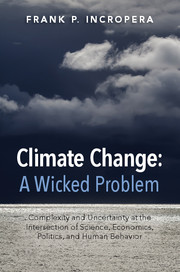 Climate Change: A Wicked Problem
Climate Change: A Wicked Problem Book contents
- Frontmatter
- Dedication
- Contents
- Foreword by Anthony F. Earley Jr.
- Foreword by G.P. “Bud” Peterson
- Foreword by Arun Majumdar
- Preface
- Acknowledgments
- Abbreviations
- 1 Energy, economics, and climate change
- 2 The Earth's climate system
- 3 Greenhouse gases
- 4 Global warming
- 5 Consequences of global warming
- 6 Mitigation, adaptation, and geoengineering
- 7 Public policy options
- 8 The politics of global warming: a history lesson and future prospects
- 9 Dissenting opinions: the great hoax
- 10 The ethics of climate change
- 11 A way forward
- Appendix A Units and conversion factors
- Appendix B Fossil fuels
- Appendix C Anthropogenic sources of natural gas and methane
- Appendix D Environmental time scales and inertia
- Appendix E Coal-fired power plants: operating conditions and costs of carbon capture and sequestration
- Notes
- References
- Index
- Plate section
5 - Consequences of global warming
Published online by Cambridge University Press: 05 October 2015
- Frontmatter
- Dedication
- Contents
- Foreword by Anthony F. Earley Jr.
- Foreword by G.P. “Bud” Peterson
- Foreword by Arun Majumdar
- Preface
- Acknowledgments
- Abbreviations
- 1 Energy, economics, and climate change
- 2 The Earth's climate system
- 3 Greenhouse gases
- 4 Global warming
- 5 Consequences of global warming
- 6 Mitigation, adaptation, and geoengineering
- 7 Public policy options
- 8 The politics of global warming: a history lesson and future prospects
- 9 Dissenting opinions: the great hoax
- 10 The ethics of climate change
- 11 A way forward
- Appendix A Units and conversion factors
- Appendix B Fossil fuels
- Appendix C Anthropogenic sources of natural gas and methane
- Appendix D Environmental time scales and inertia
- Appendix E Coal-fired power plants: operating conditions and costs of carbon capture and sequestration
- Notes
- References
- Index
- Plate section
Summary
The foregoing results provide strong evidence that global warming is real and attributable in no small measure to human activities, a conclusion strengthened by other indicators that are updated annually (Blunden and Arndt, 2014; EPA, 2014b). But why should we be concerned? What is the impact of warming? How will it affect the natural environment? The built environment? Food production? Human health and security? And, although we've been careful to differentiate between climate and weather, could warming affect the frequency and intensity of extreme weather events?
The ramifications of global climate change (GCC) and their likelihood have been discussed extensively (IPCC, 2007d, 2014a; Cullen, 2010). Cullen extrapolates past and current warming trends into a prediction of circa-2050 climate. Droughts are projected to be more severe in some regions and floods in others. Depletion of ground water and food sources is predicted, as is deterioration of infrastructure in low-lying regions vulnerable to rising sea levels and storm surges of growing frequency and intensity. And the world would also have to contend with growing migrations of climate refugees.
The potential effects on ecological and socioeconomic systems are numerous and may be positive or negative, with significant differences from one region of the globe to another. Let's begin with the region in which GCC and its ramifications are most evident.
The Arctic: canary in a mine shaft
The Arctic occupies the region north of the Arctic Circle and includes northern portions of eight nations – Canada, Denmark (Greenland), Finland, Iceland, Norway, Russia, Sweden, and the United States (Alaska) – as well as the Arctic Ocean. Because warming is occurring much faster in the Arctic than in any other region of the world, it has become the proverbial canary in the mine shaft, a testimonial to the reality of global warming.
Since the 1950s, Arctic temperatures have increased at a rate more than twice the global average. Using Alaska as an example, its temperature increased by about 2°C, more than twice that of the lower forty-eight states. Were the trend to continue, an estimate of 2°C for the twenty-first-century rise in the global average temperature would translate to a 4°C increase for the Arctic.
- Type
- Chapter
- Information
- Climate Change: A Wicked ProblemComplexity and Uncertainty at the Intersection of Science, Economics, Politics, and Human Behavior, pp. 80 - 107Publisher: Cambridge University PressPrint publication year: 2015
